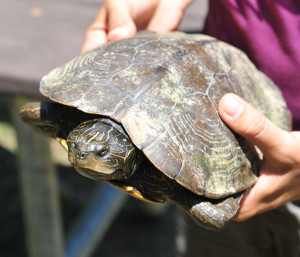Richard Seigel, a Towson University professor of biology, has focused his field research on the northern map turtle, which makes its home in several states, including Maryland, where they are classified as endangered.
That research brought him to Port Deposit, a small town in northeast Maryland on the Susquehanna River, where a collaborative conservation effort has been cultivated.
Seigel recently sat down with National Geographic to talk about the turtles and the innovative partnership they have inspired. Here is an excerpt from the story:
Tell us about the turtle and the town.
Typically when you have an endangered species that has habitat requirements within any town boundaries there is potential for conflict and fears that there will be rules and regulations that will hamper the economy. But in the case of Port Deposit, the opposite happened.
The town adopted the turtle as its symbol and mascot, and the town has put its money where its mouth is. It has gotten investment from the state and federal government and private funding, and it is making the turtle a center of economic development, through ecotourism.
How that happened is a much longer story, but the bottom line is that rather than the town responding with, “We don’t want anything to do with an endangered species,” they have been tremendously supportive of our research. They have been our eyes and ears for watching what the turtle does and they have taken all sorts of voluntary measures. It has resulted in a large series of grants and contracts to improve the habitat within the town. …
What is the most surprising thing about the northern map turtle?
I think the fact that they have existed in this river so long without a lot of people knowing about them. We do most of our observation work from spotting scopes, and people come up and ask what we are doing. We tell them we are looking at turtles, and they say they fished there for a long time and didn’t know turtles were there. But now they start seeing them.
Read the full National Geographic story here.

